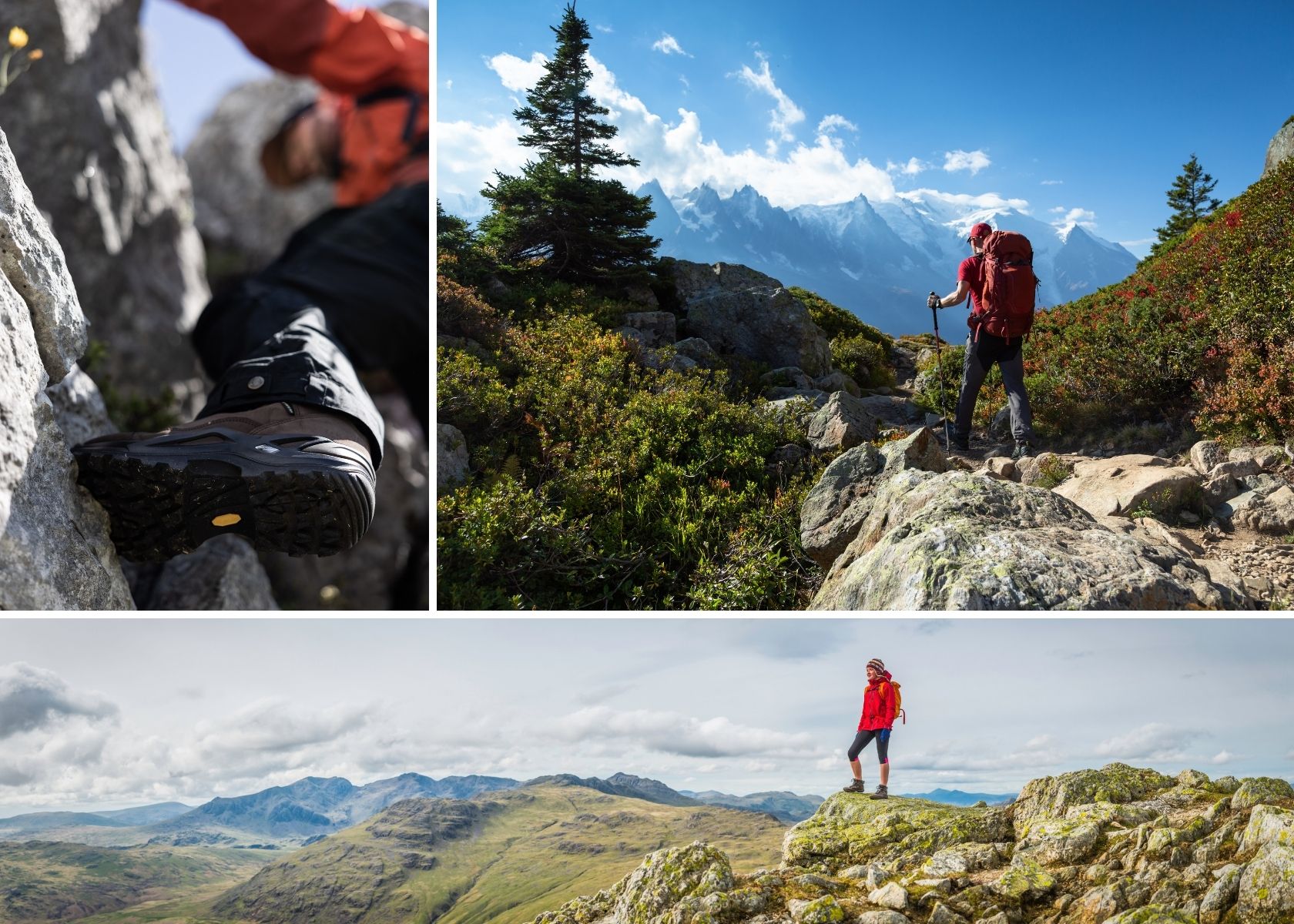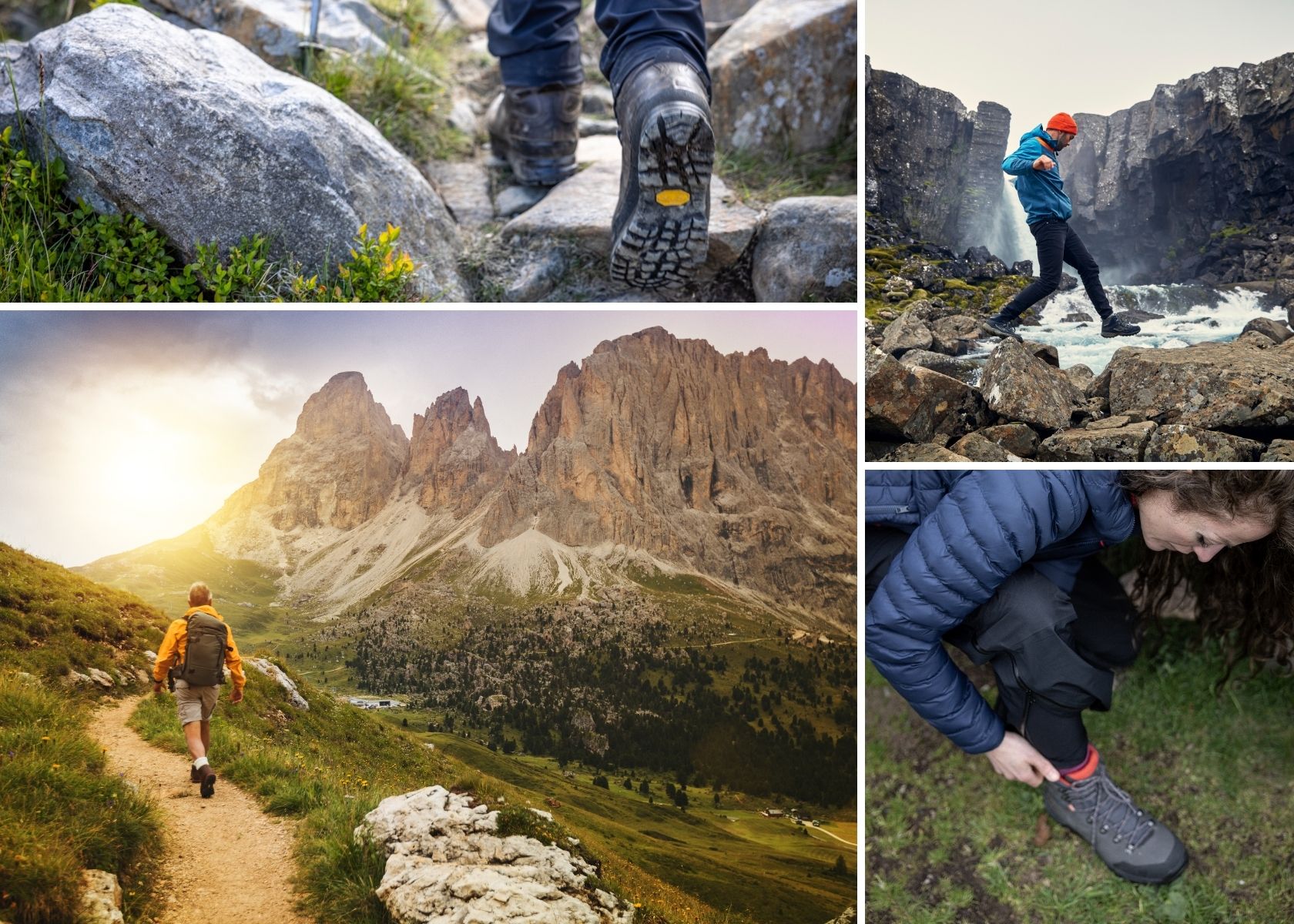WALKING BOOT BUYING GUIDE
Whether you’re exploring the remotest corners of the UK or taking to high-up trails in far-flung locations, you need boots that are built to keep up. But the question of which footwear is the best is not a straightforward one, since it depends on what you’ll be doing and where – so here’s our breakdown of everything you need to know to make the right decision. And if you’re still not sure, visit us in-store where one of our experts will help you pick your perfect boot, and fit it to you for free, too.
What Are Walking Boots? Why Are They So Important?
Walking boots, often called hiking boots, are footwear designed to protect your feet and ankles during outdoor activities across varied and sometimes demanding terrain. Unlike trainers or street shoes, walking boots provide crucial advantages:
- Support: Ankle cuffs, sturdy soles, and internal shanks stabilise your foot and lower leg on uneven ground.
- Protection: Thick materials, toe caps, and rands shield your feet from rocks, roots, sharp plants, and the elements.
- Traction: Deep, aggressive outsoles (tread) grip mud, grass, wet rock, and snow, reducing slips and falls.
- Comfort: Special midsoles and insoles cushion each step, protecting your joints over long distances.
Wearing properly chosen boots minimises blisters, injuries, and discomfort, turning each walk—long or short—into an experience you’ll want to repeat.
Types of Walking Boots: Find Your Level
Walking boots aren’t “one size fits all.” Your ideal choice depends on where and how you walk. Here are the most common types:
| Boot Type | Key Features | Typical Use Cases |
|---|---|---|
| Lightweight | Flexible sole, minimal ankle cuff | Lowland trails, short walks, fair weather |
| Midweight/Hill | Moderate support, stiffer sole, some cuff | Mixed terrain, rolling hills, moderate packs |
| Mountain/Backpacking | High ankle support, rigid sole, technical | Steep, rocky, or snowy ground, heavy packs |
| Winter/Technical | Insulation, crampon compatible, very rigid | Winter conditions, snow, ice, mountaineering |
Lightweight walking boots suit casual walkers, dog-owners, and summer ramblers. They are flexible, breathable, and often double as everyday shoes.
Midweight boots handle weekend hiking, muddy fields, and mixed weather. Think Lake District walks, Scottish moors, or moderate backpacking.
Backpacking or mountain boots are built for challenging routes—steep ascents, scrambling, rocky ridges, and multi-day expeditions. These often feature stiff soles, solid ankle cuffs, toe protection, and dense waterproofing.
Winter/mountaineering boots are specialised for cold, snow, ice, and are often compatible with crampons for technical climbs.
Understanding Boot Construction: Key Parts Explained
1. Upper
The upper is the outer part covering your foot and ankle. It determines breathability, waterproofing, durability, and how well the boot adapts to your foot shape. Leather uppers tend to be tougher and more water resistant. Synthetics are lightweight and dry quickly.
2. Lining
Located just beneath the upper, linings add comfort and wick away moisture. They may also house a waterproof/breathable membrane like GORE-TEX®, eVent or similar.
3. Outsole
The outsole is the “tyre” of your boot—the thick layer of grippy rubber that contacts the ground. Deep lugs provide grip in mud or loose soil; softer rubber compounds stick well to wet rock. Look for well-known outsoles (e.g., Vibram), or a deep, aggressive tread if you spend time in messy terrain.
4. Midsole
The midsole sits above the outsole and is critical for cushioning and shock absorption. Midsole materials include EVA (lightweight cushioning), PU (more durable, less cushioning), and sometimes include stiffeners/shanks for support.
5. Insole / Footbed
Removable insoles add another layer of comfort, support, and sometimes arch correction. Many custom insoles are available separately.
6. Toe Cap and Heel Counter
Reinforced toe caps protect against rocks and roots. A solid heel counter can improve stability and lock your foot in position.
7. Lacing System
Laces, eyelets, D-rings, or hooks help to fine-tune fit. Advanced systems like BOA or quick-lace dials exist, although most people prefer traditional lacing for reliability.
Choosing Materials: Leather vs. Synthetic vs. Mixed Uppers
Your choice of material impacts weight, comfort, performance, care, and price.
Leather Boots
- Pros: Durable, excellent water resistance (with care), long-lasting, supportive, good for rough or wet conditions.
- Cons: Heavier, require breaking in, need regular maintenance (cleaning, proofing), and can be warmer in summer.
Synthetic Boots
- Pros: Lightweight, quick to dry, often more affordable, minimal break-in, highly breathable.
- Cons: Less durable than leather, can wear more quickly in tough conditions, need a membrane for waterproofing.
Mixed/Composite Uppers
Many modern boots use strategic combinations of materials, such as leather toes/heels for protection and synthetic mesh for breathability. These hybrids aim to balance durability and comfort.
Expert Tip: For long walks on rough ground or in consistently wet climates like Britain, leather often edges out for longevity and protection—but many synthetic boots perform superbly for three-season use.
Finding The Best Fit: Sizing, Width & Foot Shape
Fit is everything. Here’s how to get it right, avoiding the most common cause of foot pain: poorly fitting boots.
Key Points:
- Always try on boots with the same socks you plan to use outdoors.
- Shop later in the day—your feet swell as you walk.
- There should be a thumb's width of space at the toe when standing.
- Boots should feel snug at the heel and ankle, but not tight or pinching at any point.
- If your toes touch the end when descending, the boot is likely too small.
- Don’t expect boots to “give” much—modern boots should feel comfortable from the start.
- Check the width as carefully as the length; foot width plays a huge part in all-day comfort.
- Consider volume: people with high arches, low arches, or high insteps may need to choose specific fits or aftermarket footbeds.
High arches? Look for boots with supportive insoles and ample midsole cushioning.
Wide feet? Many brands offer wide (and sometimes extra-wide) fittings. Don’t settle for "just okay"—our experts will measure your feet to ensure the perfect fit for you.
Seasonal and Terrain Considerations
Walking Boots for British Weather
- Wet/muddy UK winter: Opt for waterproof leather or lined synthetic boots. Look for deep, widely spaced treads to shed mud.
- Summer/dry: Lightweight, breathable boots or even walking shoes may suffice—just ensure there’s still enough support if you’re carrying a pack.
- Snow/ice: Seek insulated boots, possibly with crampon compatibility for technical treks.
Terrain and Use Case
- Lowland/park trails: Flexible walking shoes or boots, lighter materials.
- Moors, muddy fields: Stronger, waterproof boots with ankle support and aggressive tread.
- Mountains, rocky routes: High ankle support, stiff midsole, durable (leather or synthetic), toe and heel caps.
- Technical hiking/expeditions: Think winter boots—rigid, insulated, and crampon-ready.
Breaking In and Caring For Your Boots
How To Break In New Boots
While some modern boots are comfortable out of the box, expect a short break-in period—especially with leather. Wear your boots around the house with hiking socks, then increase use on gentle local walks before tackling long routes.
How To Care For Walking Boots
- After Every Walk: Brush off mud, dirt, and debris. Remove insoles and laces so the inside dries properly.
- Drying: Air-dry naturally, away from direct heat sources that can crack leather or damage adhesives.
- Cleaning: For leather boots, clean with specialist products and re-proof regularly to maintain waterproofing. Synthetic boots also benefit from cleaning and the occasional waterproofing spray.
- Storage: Store in a dry, well-ventilated place.
Well-cared-for boots can last years, and maintaining yours also protects your feet on every adventure.
Essential Walking Boot Technical Terms (Glossary)
Walking Boots FAQs
Go for a size that leaves roughly a thumb’s width at the toe while standing, with hiking socks on. Boots should fit snug at the ankle/heel, with room for toes to move. Many people need to go half a size up compared to regular shoes for best comfort in thick socks.
They should feel supportive, not tight. No pinching, no toe-box pressure, and no heel slip. Try boots in the afternoon, since feet swell during the day.
Leather is durable and offers natural weather resistance, ideal for rough terrain or multi-season hiking. Synthetics are lighter, quick-drying, and well-suited for three-season use or people seeking lighter weight.
For flat or easy terrain in dry weather, walking shoes can be lighter and more comfortable. Boots offer superior ankle support, protection, and are recommended for uneven, muddy, or rough terrain.
Regularly clean and dry your boots post-walk, re-proof waterproof boots, and store in a cool, dry place. Don’t dry boots on radiators—always let them air dry.
Most boots require a short break-in period, especially if leather. Start by wearing them around the house and on short walks.
Women's boots are shaped for narrower heels and a lower ankle bone, plus may offer different sizing and colourways. Always buy what fits and feels right for your unique feet.
Related Articles

Let us know you agree to cookies
We use marketing, analytical and functional cookies as well as similar technologies to give you the best experience. Third parties, including social media platforms, often place tracking cookies on our site to show you personalised adverts outside of our website.
We store your cookie preferences for two years and you can edit your preferences via ‘manage cookies’ or through the cookie policy at the bottom of every page. For more information, please see our cookie policy.







